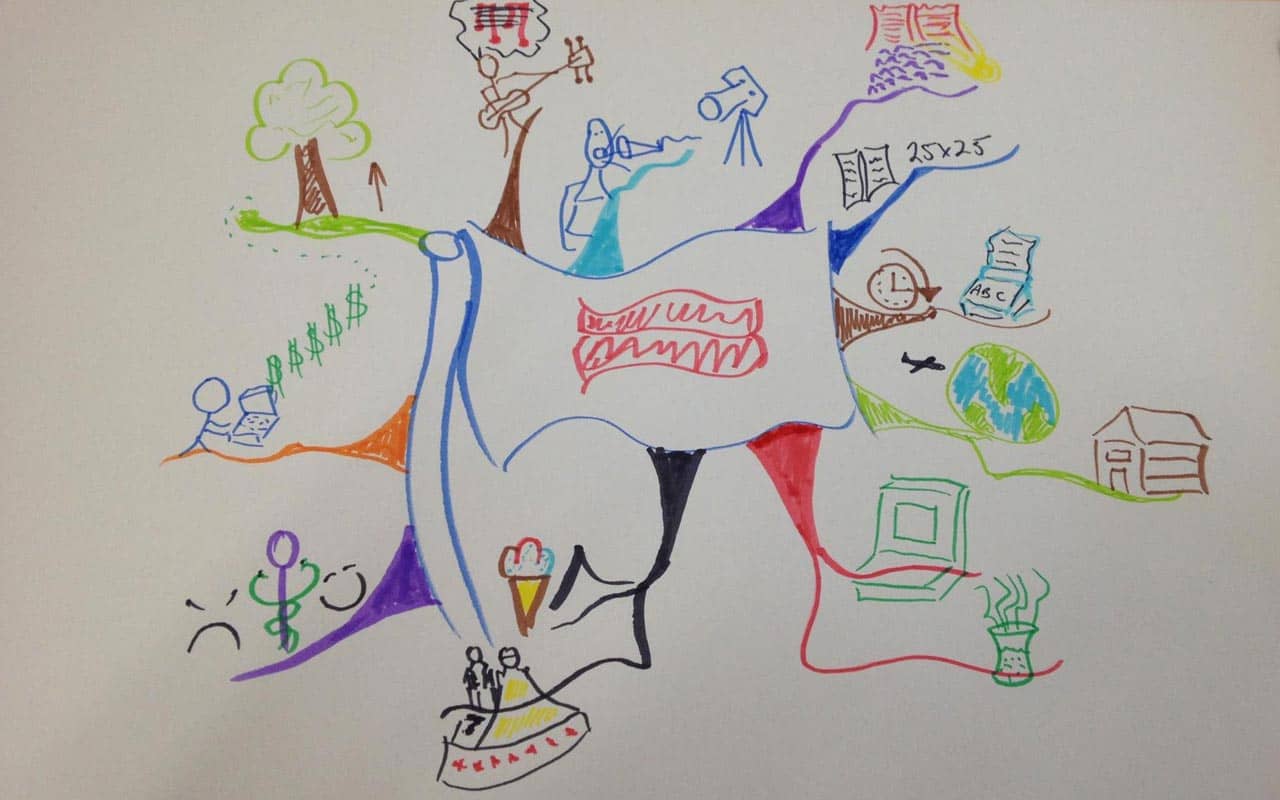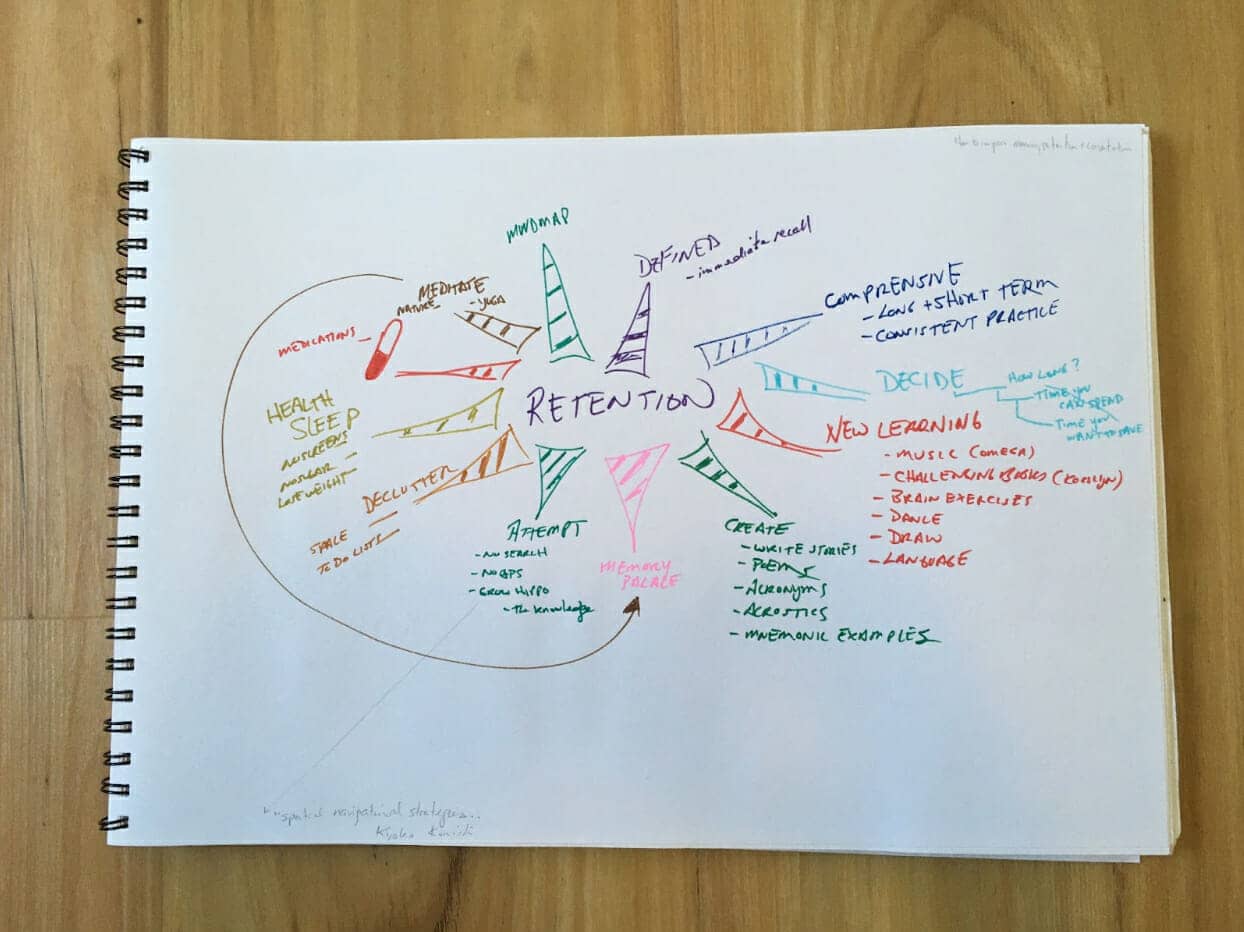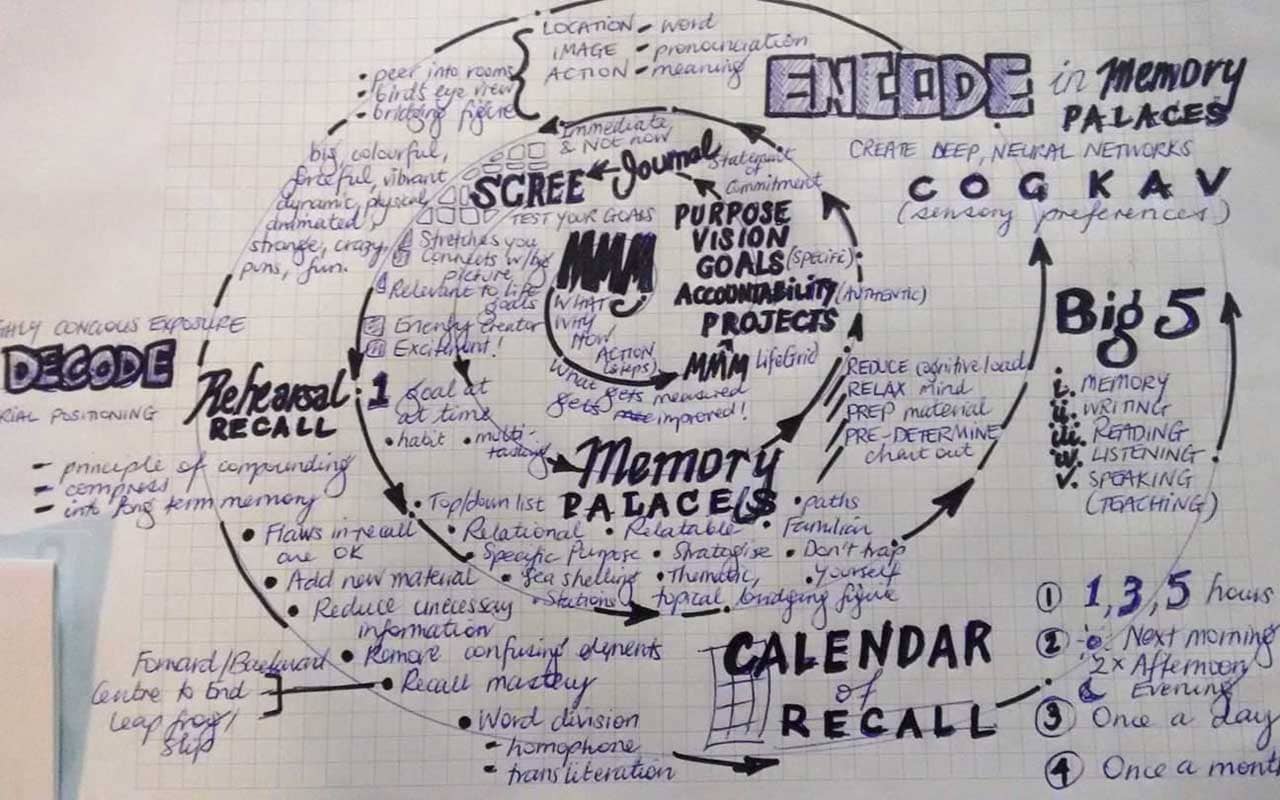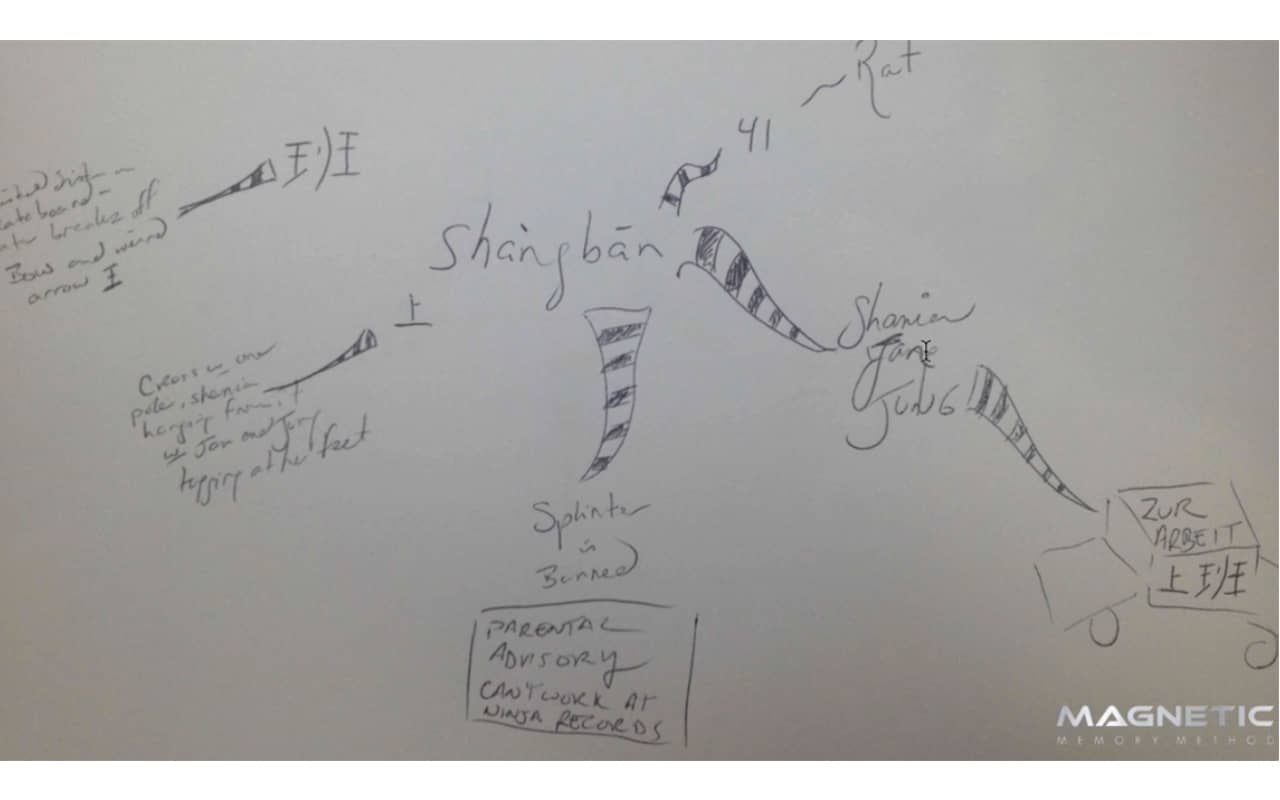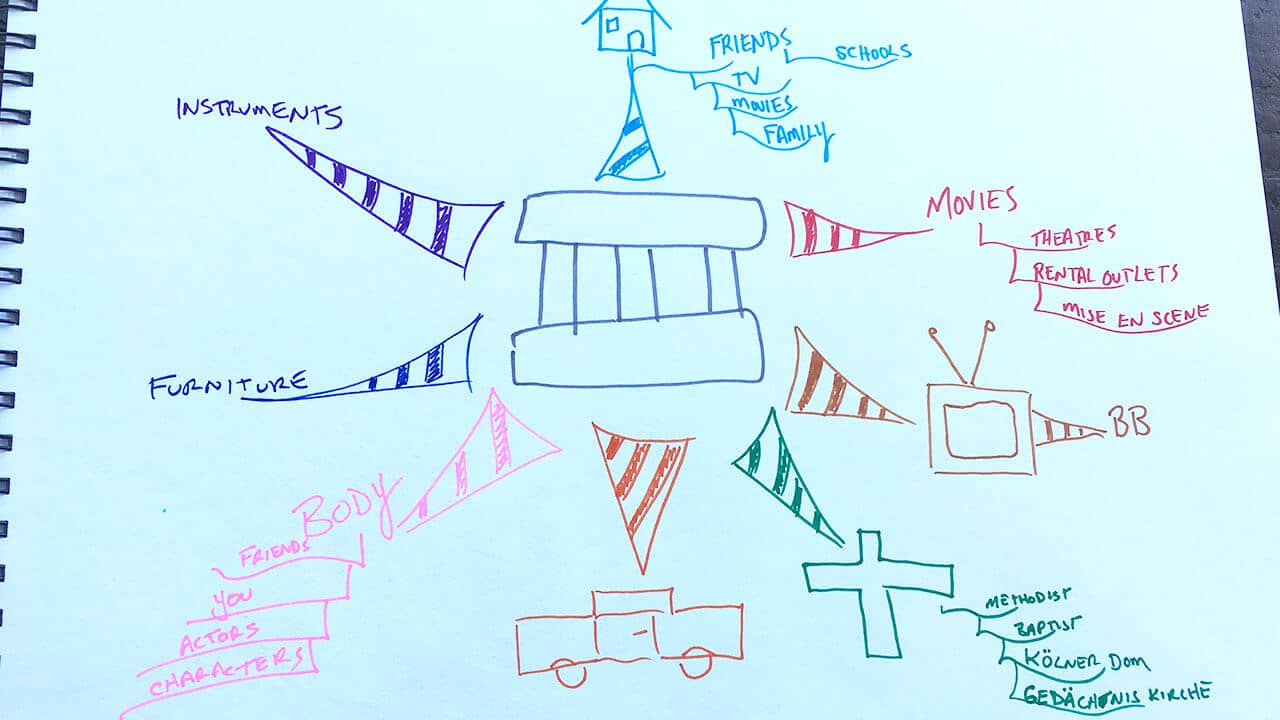 I was skeptical of mind maps until Tony Buzan personally taught me how to use the technique in ways that unpack the true benefits of mind mapping.
I was skeptical of mind maps until Tony Buzan personally taught me how to use the technique in ways that unpack the true benefits of mind mapping.
In case you don’t know Buzan, he wrote many bestselling books on the topic.
But I still wound up ignoring his device because I wrongly assumed there was no way mind mapping could be so good.
Thankfully, I took his advice when we met and I still follow the mind map I created under his guidance.
I’ve created many more mind maps since and they have never failed to help me achieve some impressive goals.
In fact, a lot of the posts I’ve written for this blog started as mind maps using a few special ingredients I’d like to share with you today.
Ready to learn more about this special tool for creativity, planning, brainstorming and remembering more?
Let’s dive in!
What Are Mind Maps Are & How They Help
As usual, different people define mind maps in a variety of different ways.
I like the definition Tony Buzan gave best. He told me that it was a means of “radiant thinking.” Of allowing your creativity to go “supernova.”
In Mind Map Mastery, Buzan defined mind mapping:
…initially as an innovative form of note-taking that can be used in any situation where linear notes would normally be taken, such as attending lectures, listening to telephone calls, during business meetings, carrying out research and studying. However, it quickly became clear that Mind Maps can also be used for ground-breaking design and planning; for providing an incisive overview of a subject; for inspiring new projects; for uncovering solutions and breaking free from unproductive thinking, among many other things.
In my experience, mind mapping does offer all of these outcomes. And as you’ll see, it can also help boost memory, a goal that Buzan says he ultimately abandoned in favor of teaching mind mapping for other outcomes. I’ve always thought that his decision was premature, and I’m excited to share with you ways that mind mapping can help with memory improvement.
X Benefits of Mind Mapping
As we go through these advantages of mind mapping, keep in mind that it’s important to experiment and explore the technique in a variety of ways.
If any ideas arise that you don’t see covered here, or by other mind mapping experts like Phil Chambers and Joseph Rodriguez, follow your instincts. It’s just ink and paper, so you have nothing to lose.
One: Rapid Career & Business Planning
I created the mind map that finally changed my mind about the technique when I met Tony at a ThinkBuzan event. I told him about my hesitations around using the technique to plan my entire business, and he reminded me to simply take the core ideas and give it a try.
I’m glad I did and here’s what that mind map, which I still refer to often, looks like:
Basically, this highly visual mind map represents the core goals I have for my work with the Magnetic Memory Method.
Although it might not make sense to others, I can see and understand at a glance the goals I’ve set for myself. At the seven o’clock position, for example, I see a quick doodle of the symbol for medicine with a sad face and a happy face. This symbolized my commitment to help nurses and doctors with mnemonics for medical terminology.
Since getting this goal visualized on this mind map, I’ve:
- Written and released two editions of How to Learn and Memorize Medical Terminology
- Written many posts for medical students on this blog
- Started a medical mnemonics podcast with one of my most successful nursing graduates
- Shared some of my own medical history to inspire all kinds of people to improve their health by releasing The Victorious Mind
All that from just one on the tributaries on this mind map. “Tributaries” was Buzan’s word for the colorful, triangle-like shapes that you extend from a central image that established the theme of a mind map.
Here’s the point: If you want to achieve your goals, mind mapping them will likely help. The trick is to keep the mind map in view so that it helps you maintain your focus.
Two: Creative Depth
I write a lot of books, articles and video scripts. Many are successful because I take the time to dig deep into the issues worth discussing by mind mapping using the basic principles Buzan suggested.
For example, here’s a mind map I created while planning a blog post about how to retain information:
In addition to using tributaries, I have benefitted from Buzan’s suggestion to switch colors frequently. It provides a form of interleaving as you give your mind a break to come up with more ideas.
By boiling ideas down to simple keywords and giving your self space for a few bullet-points, you can create an unconventional outline that will make your writing unique in just a few minutes.
I have also mind mapped fiction as well. My well-received “Memory Detective” novel Flyboy, started as a mind map, for example.
Three: Note-Taking
A great way to use mind mapping basically involves creating a concept map to help you better understand a topic. Unlike planning your career or brainstorming creative ideas for writing projects, mind maps help you visualize the relationships between ideas.
In one mind map example I explained in a detailed video, I arranged my notes for a book I’d read visually:
But my favorite mind map example comes from one of my students who mind mapped the Magnetic Memory Method Masterclass. Check it out:
As you can see, Keko used the circular structure all of my own mind maps use. But she adopted her own style. Her “seashell” structure really make the keywords pop at a glance.
That’s important because one of the most important benefits of mind mapping comes from being able to understand something as quickly as possible. Unlike note-taking in a journal and having to flip through dozens of pages, the benefit here is that you can see all of the main ideas at a glance. If you want to go deeper on any of the details, they are also on the same page in the bullet points.
Four: Spaced-Repetition
Phil Chambers has shared an incredible way to use mind maps for spaced-repetition. If you don’t know about this special memory technique, briefly, it’s a means of reviewing information in a manner optimized to create long-term memories quickly.
His suggestion in 101 Top Tips for Better Mind Mapping is this:
Every time you review a mind map, leave a roman numeral. That way you have a general idea of how many times you’ve revisited the information.
This might seem like a subtle point, but the benefit is that people often don’t track their activities enough. What isn’t measured is harder to improve.
So when students tell me that they have tried a technique, I usually ask them how many times and over what period of time. When they can’t tell me, I share Phil’s suggestion so that they have an accurate record. Memory athlete Johannes Mallow has shared similar ideas for tracking how often you show up to practice and review. And overall, tracking your progress is a well-established aspect of what top performers call deliberate practice.
Tracking how many times you’ve reviewed the ideas on your mind maps using Roman numerals is very deliberate, indeed.
Five: Fluency Boosts
Let’s face it: learning a new language is challenging. But this study shows that mind mapping is an effective means of remembering vocabulary. Yet another study has found that students not only learn vocabulary better when incorporating mind mapping as part of language learning. They enjoy the process much more too.
I experienced this myself when I incorporated basic mind mapping principles when successfully completing Level III in Mandarin Chinese a few years back.
Here’s one of the mind maps I created to help me while I worked towards getting the Level III certificate:
Although I did not use a central image, but rather the pinyin on these mind maps, I incorporated drawings whenever I could.
The benefit of having more fun was not produced so much by drawing pictures, but from:
- Being able to see the many parts of the Chinese characters at a glance
- Having a repeatable process to follow that kept me in a state of flwo
- Being able to treat the mind map as a mental journey using the method of loci
If you’ve ever found language learning too challenging for your tastes, I’m sure you’ll benefit from injecting some creativity and fun into the process by incorporating at least a little mind mapping.
Six: Mastering the Art of Memory
As I mentioned above, Buzan more or less stopped teaching mind mapping for memory in the 1980s. Although Phil Chambers has continued sharing his Roman Numeral idea, I’m not sure he’s explored mind mapping much further for memorization than that either.
But as you’ve seen, I used mind maps for language learning quite successfully. It gets even better if you’re interested in adding mnemonics.
You see, sometimes when people are new to the art of memory, they worry about whether they’ll be successful with the Memory Palace technique. Often, they worry that they won’t be able to find enough Memory Palaces easily to help them reach their learning goals.
A major benefit of mind mapping is that it helps you rapidly generate many Memory Palace options. This feature is something I discussed in-depth in my tutorial on using mind maps in combination with the method of loci.
Here’s an example mind map that helped me generate dozens of options in just a few minutes:
Given how powerful the Memory Palace technique can be, it’s well worth exploring further.
To get started, start with a central image and use multiple colors and tributaries to generate possible locations you could use. On the mind map I’ve shared above, you can see that I identified everything from the homes of friends and family to mnemonic locations in movies and series, to churches and cars.
You might laugh at the idea that a car can serve as a Memory Palace. But that’s exactly what James Gerwing used to help him win the 2019 Canadian Memory Championship.
How to Harness the Many Powers of Mind Mapping
In a word: start.
I personally waited too long myself. Life would be very different had I been using this technique since elementary school. I would probably have accomplished much more in life, a lot sooner.
Still, I have no regrets. I’m just glad that I listened to Buzan’s advice and started exploring and experimenting with the technique. I’ve written many more books as a result, taken calculated risks without worrying to much and accomplished deeply personal goals that I had mistakenly believed were impossible.
Mind mapping might not be a magic bullet, but it does just what Buzan promised:
It helps make your ideas radiate. And with just a little bit of practice following the principles I’ve shared today, your ideas and desires stand a chance of going supernova.
If you’d like more ideas and help learning to use memory techniques in a “supernova” way, check out this Buzan-approved memory course I created for you:
Now that you know more about why mind maps are so great, I’m confident you’ll love the video lessons and worksheets I’ve got for you within.
After all, if I hadn’t had both Memory Palaces and mind maps myself, my own progress would have been even slower.
So what do you say?
Are you ready to apply mind mapping to your goals?
Here’s to taking action!
Related Posts
- How To Combine Mind Mapping And Memory Palaces With Phil Chambers
Reigning World Mindmapping champion Phil Chambers joins us to talk about Mindmapping and how to…
- The Difference Between Mind Map and Concept Map Explained
Mind map vs concept map? Which one's better? The answer comes down to your goals.…
- 7 Powerful Mind Mapping Examples For Better Method of Loci Success
Mind mapping improves memory and creativity. These mind mapping examples for using the method of…

